“Sir Jonathan” Lear challenges pupils to set up a healthy living centre
Learning how to keep healthy is high on the agenda of all schools. This topic takes a fresh approach to learning the key issues around developing and maintaining a healthy lifestyle.
Before you start, it’s a good idea to contact your local health/sports centre to see what support they could offer. It may just be information, but you’re likely to get much more. Lots of centres will bend over backwards to help a school promote healthy living, and prior knowledge of potential opportunities will allow you to direct the children’s learning throughout the challenges that lie ahead.
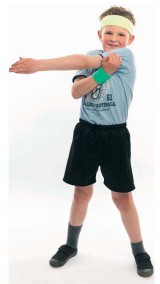 Getting into role…
Getting into role…
A little preparation is required before the first session takes place. Make a set of name cards, one for each child and decide on the groupings for the duration of the topic (splitting the class into about four evenly sized groups seems to work well). Set up a space as a boardroom (ideally not the classroom) with the tables placed in the middle and chairs around the outside. Name cards are added to the table to guide the children to the right places. Take your place at the head of the table (ideally with a slight costume change – I usually wear a tie to smarten myself up a bit!) and await the arrival of the children. If possible, have a little music playing – the various themes from the TV show The Apprentice are available on iTunes and set the tone perfectly.
When the children have settled, address them in role. (I insist on being called ‘Sir Jonathan’ and attempt to maintain an unsmiling, stern looking Alan Sugar persona throughout.) Tell them that you have been informed by their teacher that they are a reasonably bright lot (I never go overboard with praise in the boardroom), and as a result, they have been set a challenge. They are about to split into teams to set up, promote and run a healthy living centre.
 Keeping up the pretence…
Keeping up the pretence…
As the teams are dismissed from the boardroom, I take the opportunity to slip, unnoticed, out of my Sir Jonathan character and resume my role as teacher, innocently inquiring as to what’s been going on and who that important looking person was that I just saw leaving. (I’ve yet to meet a child who doesn’t happily go along with it – some even help to add to the story – one child told everyone in his group that he’d seen Sir Jonathan’s helicopter leaving the school grounds!)
The boardroom now becomes the focal point for all future tasks and presentations completed by each team. The children will, for example, be brought back to the boardroom to share a progress report, pitch an idea, or present finished work. Tasks are delivered by Sir Jonathan; usually in a sealed envelope, or if you’re feeling adventurous, a prerecorded video link, and the teams are given clear deadlines that they must work to.
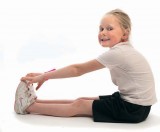
Looking beyond physical fitness…
To enable the children to get to grips with the challenge, the first task requires each team to brainstorm the term ‘healthy living’. What does this mean? What does it involve? Each team must come up with their own ideas and think as broadly as possible.
It may be necessary to support teams through this process; it’s important that they take a holistic view of healthy living and look beyond a focus on physical fitness. What does it mean to have both a healthy mind and a healthy body?
The session is designed to help the groups collect initial ideas for their healthy living centre bran. What would your healthy living centre stand for? This could lead onto the creation of a mission statement – ‘we believe in a place where you can exercise your mind as well as your body, a place where healthy food comes hand in hand with healthy conversation…’
At this stage, ideas can be left a little rough around the edges. The teams will have time to refine their brand in the following session before the daunting prospect of presenting to Sir Jonathan in the boardroom.
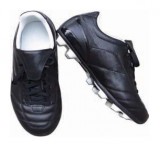
Building a brand…
Using magazines, TV adverts, billboards and celebrity endorsements, allow the children to discuss the ways in which companies promote their brand and products. Focus on advertising that promotes an active, healthy lifestyle such as sportswear brands (Nike, Adidas), food; exercise (Wii Fit) etc. Nike is famous for having three words that sum up its brand – what does ‘Just do it’ mean? Why do people relate to this? Would the brand be as powerful if the slogan was ‘You can give it a try if you like’?
In their teams, allow the children to identify the elements that make up the healthy lifestyle market. What’s out there? How are lifestyle products presented to the customer? Draw their ideas together and identify common threads such as positivity, aspiration and the fulfilment of dreams. Will the products really make a difference? If I buy the football boots that Wayne Rooney wears, will I be a better footballer? If I drink that sports drink will it give me the edge? If I eat a healthy choice meal does that make me healthy?
Remind the teams about their initial ideas for their healthy living centre brand and encourage them to decide how they would promote it. How would you make sure that your brand was aspirational yet within reach? Can you offer the dream without making impossible claims? (e.g. ‘Run as fast as Rooney’ – Bad! – ‘Rewrite the rules of speed’ – Good!) The teams must come up with a slogan to sum up their brand; this, along with their mission statement is then presented to Sir Jonathan who awaits expectantly in the boardroom.
The following tasks and challenges can be delivered in any order, omitted, or supplemented to suit the needs of the class. The ultimate aim is to prepare the teams for a number of days, or perhaps a week, where the healthy living centres will be launched and all their plans and hard work will come to fruition. As a result of this, alongside the directed tasks, each team will need time to work independently on aspects of their centre that they had prioritised.
Planning a social event…
A healthy living centre is about more than just physical well being. This activity highlights the importance of a healthy mind by focusing the children on social interaction and a sense of community. The challenge delivered by Sir Jonathan involves the planning of a social event. Teams may begin by researching the events that their own school provide, and beyond this, other organisations. Why do coffee mornings exist? Is it because the people who go have nothing better to do? Is there more to it? Can friendships be made, stories exchanged, advice given, is it good to be around other people? A recurring feature of a number of the activities is market research. The teams could explore the kind of events that would be popular. Through the process of discussion and action planning, the groups would work towards their event deciding on roles, support needed, and organisation.
 Choose your activities…
Choose your activities…
This activity involves the teams deciding on the activities they will provide to encourage physical health and well being. Most health clubs/ sports centres have informative websites that the children could explore but to really make the children think, a visit from a club manager would be ideal. To prepare for the visit, the groups would have to generate questions that would enable them to discover the kind of activities that are on offer, and also the potential manageability of basing these in school. The children should be encouraged to refine their questions to get exactly the information required: Which are the most popular activities/classes that you run? Which activities do you think we’d be able to organise in school? Could you give us any help with that?
Each team could be given 10 minutes to grill the centre manager and following the interview, would spend time collecting their ideas together. When each team has completed the process, action planning can be modelled by the teacher. If a team is interested in setting up an aerobics session, would they be able to watch a session delivered by a professional instructor? Would that instructor deliver a session or help plan a session in school? Could the team organise and deliver a short session for staff or other children themselves? How long would the session be? Which team members would be the instructors? Who would organise the space or equipment needed?
Each action plan must show clearly which activities they aim to provide, how this will be organised, staffed (members of the team) and then timetabled. This will need careful support as physical well being is only one aspect of their healthy living centre – above all else, their plans must be achievable. With plans complete, it’s off to the boardroom.
 Cooking for sir jonathan…
Cooking for sir jonathan…
The healthy living centres would be a bit of a disappointment if they didn’t practice what they preach. Any food outlet, café or restaurant that is within a health club should promote a healthy diet. This activity could be delivered in one session or over a number of sessions depending on how much time you wished spend. A simple starter task would have the teams designing menus. They would need to find out about balanced diets, explore issues such as organic vs. non-organic, GM or non-GM. Teams could build in a little market research, what do the customers (other children/staff/parents) want? To take the task further, children could add taste tests to their market research – blindfold challenges – can you tell the difference between a full fat and a low fat version? A step beyond this would be to get cooking! Could the teams produce a healthy meal that would be served to Sir Jonathan in the boardroom? Would the notoriously difficult to please business mogul be impressed with each healthy living centres’ offerings?
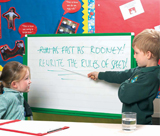 Setting up a website…
Setting up a website…
Having a healthy living centre that is brimming with activity is of little use if no one knows about it. The children’s creative thinking and ICT skills will be tested as each team is challenged to create a website for their business. If the children have already had experience of using Microsoft Office Publisher, the website formats allow for quick and professional results. On opening a website template (the best solution for those who’ve never used it before) the children are asked about ‘site goals’. They will need to decide as a team what their priorities are. Do they want their website to describe services, display calendars or schedules, show lists of activities? Each option they include will add sections to their website.
The design element must reflect their brand – how will the website draw customers in? How will you ‘sell’ your brand and your products? Allow the teams to explore and evaluate the successful elements of existing websites to help them with their ideas. To add a little competitive spice, you could insist that on the days/week when the healthy living centres open, potential customers will use the websites to decide which activities or events they would like to try. The website will be the first contact with customers; get it wrong and your centre could be deserted – not something that you’d relish explaining back in the boardroom…
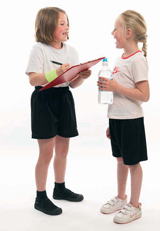 Display your ideas…
Display your ideas…
The physical environment of a health or sports club is very important. Often there are areas displaying information on a range of topics. The following challenge allows teams to identify one issue, related to a healthy lifestyle, that they develop into an interactive, informative display or presentation. It’s a good idea to give a list of potential topics for the teams to choose from; insisting that each team’s issue has to be different could lead to some interesting negotiations.
With issues decided, each team would have to think about what they already knew – if the topic was smoking – the children would know that it was bad, but why is it bad? What effects does it have on the body? They would need to decide how to present the information they’ve collected and relate it to both their brand and customers. The issue should be dealt with positively, i.e. focusing on the benefits of not smoking rather that the things that might happen if you carry on. Successful presentations could include rhetorical questions – ‘Isn’t everyone entitled to clean air?’ The group could create a physical display that customers read or watch, or maybe plan and deliver a workshop that customers are invited to during the centres’ opening week (advertised on the healthy living centre website, of course!).
Putting everything together…
Having completed the challenges and successfully negotiated the boardroom, the teams will be ready to launch their healthy living centres. With everything in place, the only thing missing is the customers. The healthy living centres will be open for at least a few days, which means there’ll be no desperate rush to get everything done. With support, the teams will have spread activities over the week to ensure they aren’t swamped. The majority of the customer base comes from other classes in school, and as each team has created a website, children can peruse the activities offered in the comfort of their own classrooms or ICT suite.
Managed correctly, each team will have the time and space in which to deliver their programme of events. Beyond school; parents, grandparents, younger brothers and sisters, the people who helped them could all be invited. They would get to see first-hand the amazing things that their children have achieved and perhaps even become a little bit healthier in the process!
KS2 Lesson plan: China and Buddism
Ace-English
8 Ways To Get Your Class Drawing
Ace-Art-And-Design
